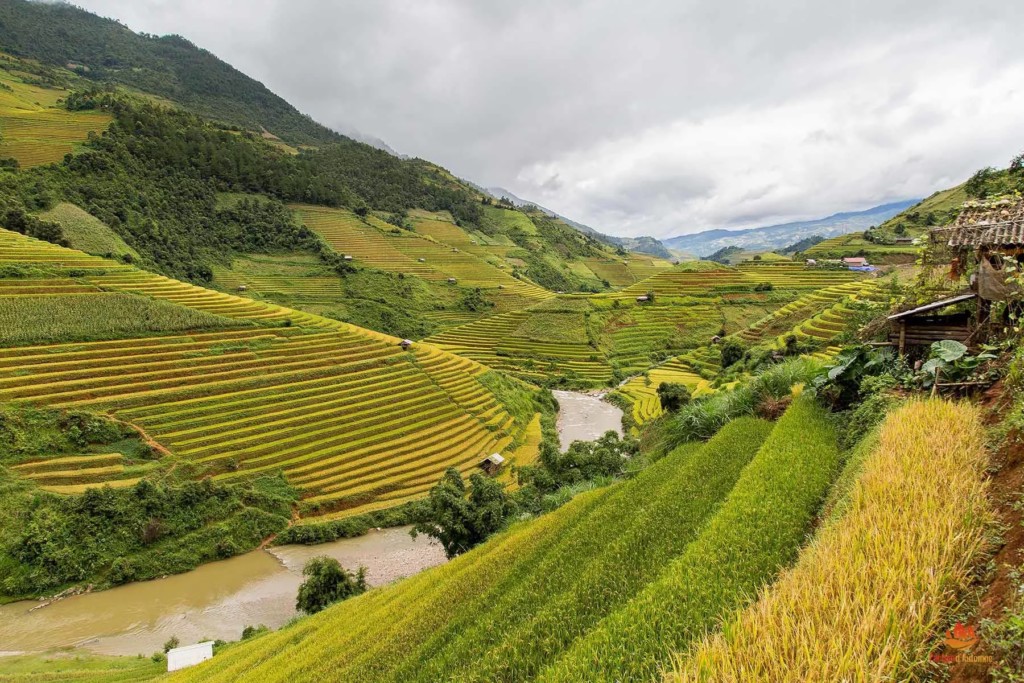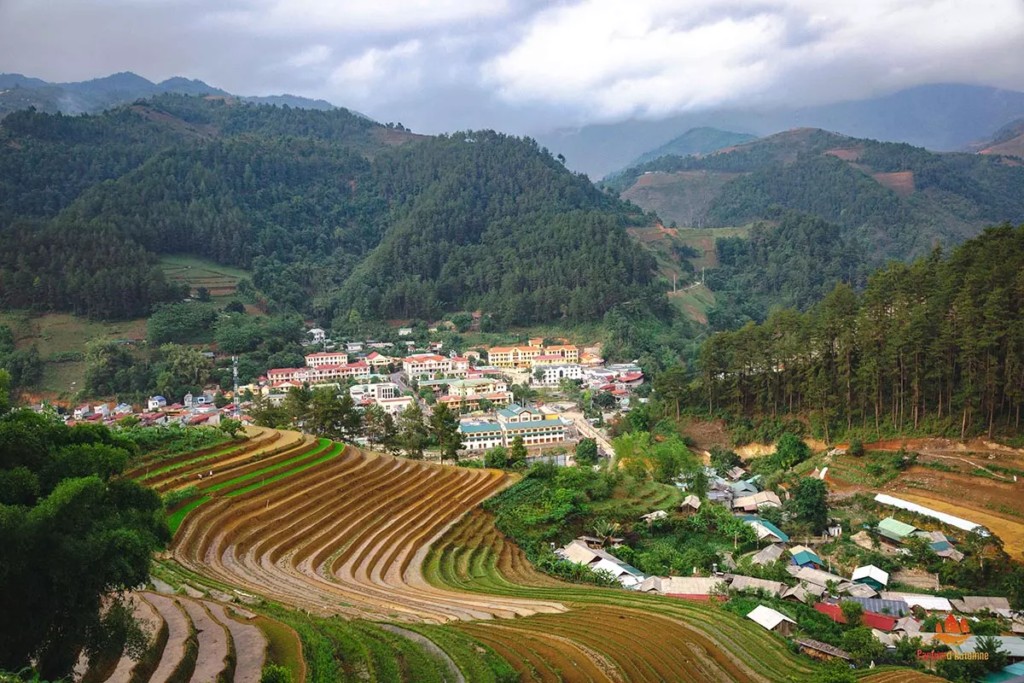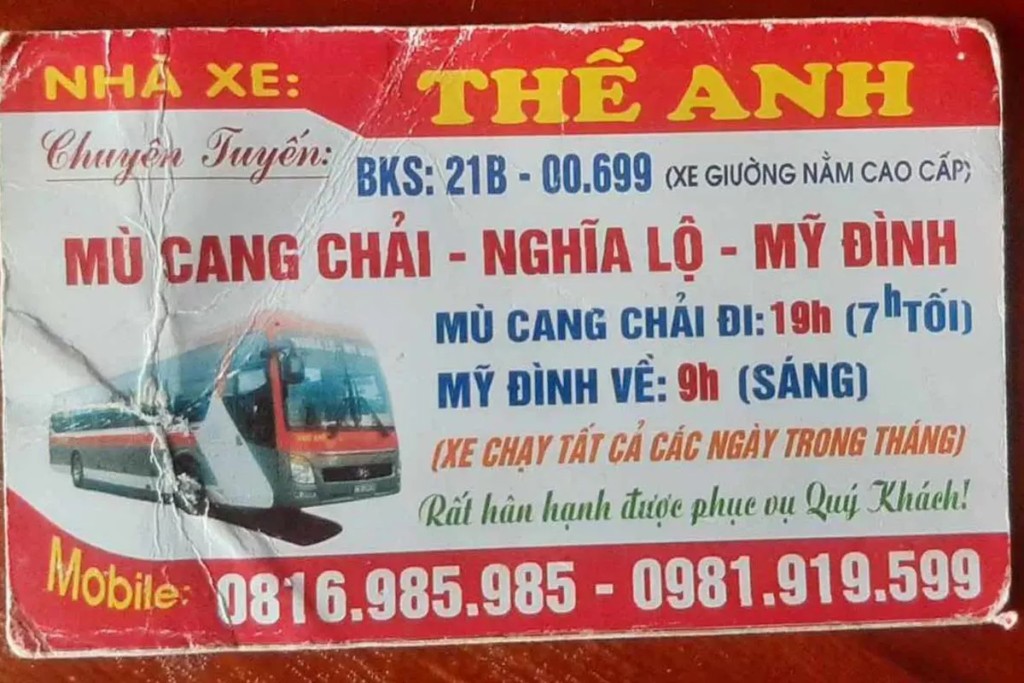Are you planning a trip to the breathtaking terraced rice fields of Mu Cang Chai in Vietnam? Figuring out the best way to get there is a crucial first step. This comprehensive guide, brought to you by SIXT.VN, will explore your transportation options, focusing on bus routes and providing valuable insights to make your journey smooth and enjoyable. Let’s dive into the details of travelling to this Northern Vietnam’s gem!
1. Why Should You Visit Mu Cang Chai?
Mu Cang Chai offers an unparalleled travel experience, blending stunning natural beauty with authentic cultural immersion. Here’s why it should be on your travel list:
1.1. Unmatched Scenic Beauty
The terraced rice fields of Mu Cang Chai are considered some of Vietnam’s most picturesque landscapes. Carved into the mountainsides by generations of Hmong farmers, these terraces create a breathtaking panorama, especially during the planting and harvest seasons. Unlike Sapa, which has seen significant tourist development, Mu Cang Chai remains a relatively untouched gem, preserving its natural charm.
 Terraced rice fields of Mu Cang Chai create a breathtaking panorama
Terraced rice fields of Mu Cang Chai create a breathtaking panorama
1.2. Cultural Authenticity
Visitors to Mu Cang Chai can deeply immerse themselves in the daily lives of local ethnic groups, primarily the Hmong and Thai. This region offers unique opportunities to discover traditional lifestyles and customs. Local markets, cultural festivals, and interactions with residents provide an authentic cultural experience, far removed from more touristy areas.
1.3. Off-the-Beaten-Path Experience
Exploring Mu Cang Chai means venturing into a region largely untouched by mainstream tourism. This sense of exploration is enhanced by the lack of extensive tourist infrastructure, allowing hikers and nature enthusiasts to enjoy less-traveled trails and exceptional panoramic views without the crowds.
1.4. Peace and Serenity
The tranquility of Mu Cang Chai is one of its most significant draws. Far from the noise and bustle of popular tourist destinations, this region offers a peaceful environment where visitors can rejuvenate amidst nature. The sounds of rivers, birds, and the wind through the rice fields create a relaxing ambiance, ideal for escaping urban stress.
1.5. Landscape Photography Paradise
For photography enthusiasts, Mu Cang Chai is a dream destination. The terraced rice fields offer spectacular photographic opportunities, especially at dawn and dusk. The play of light on the terraces, the changing colors of the crops, and the presence of local workers create stunning scenes, all with fewer tourists compared to Sapa.
2. What Activities Can You Enjoy in Mu Cang Chai?
Mu Cang Chai offers a plethora of activities that allow you to discover its breathtaking landscapes and immerse yourself in the local culture.
2.1. Trekking
Mu Cang Chai is a paradise for hikers. Hiking trails wind through terraced rice fields, forests, and mountains, providing breathtaking panoramic views. Hikes can range from a few hours to several days. The Khau Pha Pass trek is popular, offering stunning views of the valleys and rice terraces.
 Hiking trails in Mu Cang Chai wind through terraced rice fields
Hiking trails in Mu Cang Chai wind through terraced rice fields
2.2. Motorbike Tours with Hmong Guides
For a thrilling adventure, consider guided motorbike tours led by Hmong guides. These local experts know the area intimately, taking you off the beaten path through winding roads and less-traveled trails. This exploration method lets you reach remote areas and deeply understand the daily lives of the inhabitants.
2.3. Visiting the Bamboo Forest
The bamboo forest in Mu Cang Chai is another natural treasure. Located near the terraced rice fields, this forest offers a serene and calming atmosphere. Trails through the giant bamboo are perfect for peaceful walks and photography, with enchanting plays of light and shadow.
 Bamboo forest in Mu Cang Chai offers a serene and calming atmosphere
Bamboo forest in Mu Cang Chai offers a serene and calming atmosphere
2.4. Discovering Local Handicrafts
Traditional craftsmanship is integral to Mu Cang Chai’s culture. Locals, especially Hmong women, are known for their weaving and embroidery. Visiting local villages allows you to observe artisans, learn about ancient techniques, and purchase handmade souvenirs. Local markets offer colorful textiles and handcrafted jewelry reflecting the region’s rich heritage.
2.5. Participating in Agricultural Activities
Engaging in agricultural activities provides a unique cultural experience. Visitors can join local farmers in planting or harvesting rice in the terraced fields. This hands-on experience provides insight into the hard work and traditional methods used by farmers, offering a chance to connect with locals and understand their way of life.
3. When is the Best Time to Visit Mu Cang Chai?
Mu Cang Chai can be visited year-round, but certain times are ideal for enjoying its landscapes and activities. The best times depend on the stages of rice cultivation and weather patterns.
3.1. Climate Overview
Mu Cang Chai has a mountainous climate with four distinct seasons:
| Season | Months | Characteristics | Activities |
|---|---|---|---|
| Spring | March to May | Pleasant temperatures, blooming trees | Hiking, exploring villages |
| Summer | June to August | Rainy season, lush landscapes | Photography |
| Autumn | Sept to Nov | Golden rice fields, best views | Harvesting, cultural events, photography |
| Winter | Dec to Feb | Cold climate, peaceful atmosphere, fewer tourists | Tranquil retreats |
3.2. Rice Cultivation Stages
The terraced rice fields follow a precise agricultural cycle:
| Stage | Month(s) | Description | Activities |
|---|---|---|---|
| Field Prep | May | Plowing fields, creating water reflections | Photography |
| Transplanting | June to Early July | Planting young rice seedlings, vibrant green fields | Participating in planting |
| Growing | July to August | Rice plants grow, lush green landscapes | Hiking, enjoying the scenery |
| Harvesting | Sept to October | Terraces turn golden as rice ripens, iconic harvest scenes | Participating in harvest, attending festivals |
3.3. Local Events
Terraced Rice Fields Festival (Late September): Celebrates the beauty of the rice fields and local culture with performances, photo contests, and craft exhibitions.
Ethnic Markets: Active throughout the year, especially during the harvest, these markets offer crafts, cuisine, and fresh products. The Mu Cang Chai market, held every Sunday, is a must-visit.
3.4. Tips for Travelers
- Photographers: Visit in May-June for green plants and September-October for golden fields.
- Hikers: Plan hikes based on climatic seasons and agricultural activities.
- Cultural Immersion: Participate in agricultural activities during transplanting and harvesting.
4. How to Get to Mu Cang Chai?
Traveling to Mu Cang Chai can be an adventure due to its remote location in the northwest mountains of Vietnam. Several transportation options are available, including buses, private cars, and motorbikes.
4.1. By Bus from Hanoi
Taking a bus from Hanoi is a common and economical way to reach Mu Cang Chai.
- Departure: Buses leave from My Dinh Bus Station in Hanoi.
- Routes: Direct buses to Mu Cang Chai or buses stopping in Nghia Lo are available.
- Travel Time: Approximately 7 to 8 hours, depending on traffic and stops.
- Schedule: Buses typically depart in the early morning or evening. Check schedules and book tickets in advance.
- Cost: Around 250,000 VND (approximately 10 EUR).
 Bus company for going to Mu Cang Chai
Bus company for going to Mu Cang Chai
4.2. By Private Car
Renting a private car offers more comfort and flexibility.
- Route: Drive from Hanoi to Mu Cang Chai via Nghia Lo, offering scenic mountain and valley views.
- Travel Time: About 6 to 7 hours, depending on stops.
- Advantages: Stop at your leisure for photos or to visit villages.
- Cost: Between 2,000,000 VND and 3,000,000 VND (approximately 85 to 130 USD) per day with a driver.
4.3. By Motorbike
Traveling by motorbike is an exciting option for adventurers (ensure you have an international motorcycle license).
- Rental: Rent a motorbike in Hanoi or Nghia Lo.
- Route: The ride features mountains, rice fields, and forests.
- Travel Time: About 8 to 9 hours, with frequent stops. Consider stopping overnight in Nghia Lo.
- Safety: Have good riding experience, wear a helmet, and follow traffic rules.
4.4. Recommended Route via Nghia Lo
A scenic route passes through Nghia Lo, a charming town for a break.
- Hanoi to Nghia Lo: 4 to 5 hours by bus or car.
- Nghia Lo to Mu Cang Chai: 2 to 3 hours, with beautiful views of rice fields and mountains.
5. Where Can You Stay Overnight in Mu Cang Chai?
Mu Cang Chai offers various accommodation options, from homestays to guesthouses and resorts.
5.1. Homestays
Homestays provide an excellent way to immerse yourself in local culture. These are often run by Hmong or Thai families.
- Example: Sanh Nhon – The Homestay (Budget-Friendly). Expect to pay around 10 EUR per person for a mattress in the communal area and 20-25 EUR for a private room.
5.2. Guesthouses
Guesthouses offer a balance between comfort and authenticity.
- Example: Dong Suoi H’mong Homestay & Bungalow. The cost is approximately 20-25 EUR per night.
 Dong Suoi H’mong Guesthouse in Mu Cang Chai offers stunning views
Dong Suoi H’mong Guesthouse in Mu Cang Chai offers stunning views
5.3. Resorts
For a luxurious experience, resorts offer high-end accommodations with superior services.
- Examples: Le Champ (Tu Le Valley) and Mu Cang Chai Resort (opening August 2024). Expect to pay over 100 EUR per night.
6. Discover Mu Cang Chai with SIXT.VN Tours
For an organized exploration of Mu Cang Chai, SIXT.VN offers several tour itineraries. Here are a few options, each designed for stays of less than a week:
6.1. Tour 1: Nghia Lo and Mu Cang Chai (3-4 days)
- Day 1: Arrive in Nghia Lo, explore the town.
- Day 2: Travel to Mu Cang Chai, visit rice terraces.
- Day 3: Hike Khau Pha Pass, motorbike ride with Hmong guide.
- Day 4: Explore Mu Cang Chai, return to Hanoi.
6.2. Tour 2: Nghia Lo, Mu Cang Chai, and Sapa (5-6 days)
- Day 1: Arrive in Nghia Lo, explore.
- Day 2: Travel to Mu Cang Chai, visit rice terraces.
- Day 3: Hike, motorbike ride with Hmong guide.
- Day 4: Travel to Sapa, explore the town.
- Day 5: Visit ethnic villages around Sapa.
- Day 6: Return to Hanoi.
6.3. Tour 3: Mu Cang Chai and Around (4-5 days)
- Day 1: Arrive in Mu Cang Chai, visit rice terraces.
- Day 2: Hike Khau Pha Pass, visit Hmong villages.
- Day 3: Motorbike ride, participate in local activities.
- Day 4: Explore surroundings, return to Hanoi or Nghia Lo.
- Day 5 (optional): Free time in Nghia Lo, return to Hanoi.
7. Direct Buses to Mu Cang Chai: What You Need to Know
7.1. Are Direct Buses Available?
Yes, there are direct buses from Hanoi to Mu Cang Chai. These buses typically depart from My Dinh Bus Station and take approximately 7-8 hours to reach Mu Cang Chai.
7.2. Why Choose a Direct Bus?
- Convenience: Direct buses eliminate the need to transfer, saving time and hassle.
- Comfort: You can settle in for the entire journey without worrying about changing buses.
- Time-Saving: Direct routes generally result in faster travel times.
7.3. Bus Companies Offering Direct Routes
Several bus companies offer direct services to Mu Cang Chai. Some popular options include:
- Ha Son Hai Van: Known for reliable service and comfortable buses.
- Khanh Thuy: Offers both standard and VIP buses.
- Thao Nguyen: A local favorite with frequent departures.
7.4. Booking Your Ticket
It’s recommended to book your bus ticket in advance, especially during peak travel seasons. You can book tickets through:
- Online Platforms: Websites like VeXeRe and Baolau allow you to compare prices and book tickets online.
- Bus Station Counters: You can purchase tickets directly at My Dinh Bus Station.
- SIXT.VN: Contact SIXT.VN for assistance with booking and travel arrangements.
7.5. What to Expect on the Bus
- Comfort: Most buses offer reclining seats, air conditioning, and sometimes Wi-Fi.
- Stops: Buses typically make a few stops along the way for restroom breaks and meals.
- Scenery: Enjoy the stunning views of the Vietnamese countryside during your journey.
8. Transferring in Nghia Lo: An Alternative Route
8.1. Why Consider a Transfer in Nghia Lo?
If direct buses are unavailable or you prefer a more relaxed journey, transferring in Nghia Lo is a viable option. Nghia Lo is a charming town located about halfway between Hanoi and Mu Cang Chai.
8.2. The Route via Nghia Lo
- Hanoi to Nghia Lo: Take a bus from My Dinh Bus Station to Nghia Lo (approximately 4-5 hours).
- Nghia Lo to Mu Cang Chai: From Nghia Lo, take another bus or hire a private car/motorbike to Mu Cang Chai (approximately 2-3 hours).
8.3. Advantages of Transferring in Nghia Lo
- Break the Journey: Allows you to break up the long bus ride and rest in Nghia Lo.
- Explore Nghia Lo: Gives you the opportunity to explore the town, visit local markets, and experience the local culture.
- Scenic Route: The journey from Nghia Lo to Mu Cang Chai is particularly beautiful, with stunning views of terraced rice fields and mountains.
8.4. Things to Do in Nghia Lo
- Visit the Local Market: Explore the bustling market and sample local delicacies.
- Homestay Experience: Stay in a traditional homestay and learn about the local way of life.
- Explore the Rice Fields: Take a walk or motorbike ride through the surrounding rice fields.
8.5. Transportation Options from Nghia Lo to Mu Cang Chai
- Local Bus: Several local buses operate between Nghia Lo and Mu Cang Chai.
- Private Car: Hire a private car for a more comfortable and flexible journey.
- Motorbike: Rent a motorbike and enjoy the scenic ride at your own pace.
9. Key Considerations for Your Trip
9.1. Accommodation
Book your accommodation in advance, especially during peak seasons. Mu Cang Chai offers a range of options, from budget-friendly homestays to luxurious resorts.
9.2. What to Pack
- Comfortable Clothing: Pack light, comfortable clothing suitable for hiking and outdoor activities.
- Rain Gear: Be prepared for rain, especially during the summer months.
- Hiking Shoes: If you plan on hiking, bring sturdy and comfortable hiking shoes.
- Insect Repellent: Protect yourself from mosquitoes and other insects.
- Sunscreen: Protect your skin from the sun.
9.3. Local Customs and Etiquette
- Dress Respectfully: When visiting temples or religious sites, dress modestly.
- Ask Permission: Before taking photos of people, ask for their permission.
- Learn Basic Phrases: Learning a few basic Vietnamese phrases will enhance your interactions with locals.
- Bargaining: It’s acceptable to bargain at local markets, but do so respectfully.
9.4. Health and Safety
- Vaccinations: Consult your doctor about recommended vaccinations for Vietnam.
- Travel Insurance: Purchase travel insurance to cover medical expenses and other emergencies.
- Food and Water: Drink bottled water and be cautious about street food.
- Traffic Safety: Be cautious when crossing roads and driving motorbikes.
10. Why Choose SIXT.VN for Your Travel Needs?
SIXT.VN offers a range of services to make your trip to Mu Cang Chai seamless and enjoyable:
- Airport Transfers: Start your trip stress-free with reliable and comfortable airport transfer services.
- Hotel Bookings: Choose from a wide selection of hotels and accommodations to suit your budget and preferences.
- Tour Packages: Explore Mu Cang Chai with expertly designed tour packages that showcase the best of the region.
- Visa Assistance: Get assistance with visa applications to ensure a smooth entry into Vietnam.
- 24/7 Support: Enjoy peace of mind with round-the-clock customer support.
11. FAQs About Traveling to Mu Cang Chai
11.1. Is Mu Cang Chai safe for tourists?
Yes, Mu Cang Chai is generally safe for tourists. However, it’s always wise to take standard safety precautions.
11.2. What is the local currency in Vietnam?
The local currency is the Vietnamese Dong (VND).
11.3. Do I need a visa to visit Vietnam?
Most nationalities require a visa to visit Vietnam. Check the latest visa requirements based on your nationality.
11.4. What is the best way to get around Mu Cang Chai?
Motorbikes are a popular way to get around, but you can also hire taxis or cars with drivers.
11.5. Are there ATMs in Mu Cang Chai?
ATMs are available in Mu Cang Chai, but it’s a good idea to carry some cash with you.
11.6. What is the internet and mobile data coverage like in Mu Cang Chai?
Internet and mobile data coverage can be spotty in some areas, so it’s good to be prepared for limited connectivity.
11.7. What are some must-try local dishes in Mu Cang Chai?
Try dishes like black sticky rice, grilled stream fish, and Mu Cang Chai green rice flakes.
11.8. Can I visit Mu Cang Chai on a day trip from Hanoi?
Due to the long travel time, a day trip is not recommended. It’s best to plan for at least a 2-3 day trip.
11.9. What are some popular trekking routes in Mu Cang Chai?
Popular routes include the Khau Pha Pass trek and trails around La Pan Tan village.
11.10. How can SIXT.VN help me plan my trip to Mu Cang Chai?
SIXT.VN offers comprehensive travel services, including transportation, accommodation, tours, and visa assistance, to ensure a seamless and enjoyable trip.
Conclusion: Plan Your Adventure to Mu Cang Chai Today
Traveling to Mu Cang Chai offers a unique and unforgettable experience. Whether you choose a direct bus or transfer in Nghia Lo, SIXT.VN is here to assist you every step of the way. With breathtaking landscapes, rich culture, and a range of activities to enjoy, Mu Cang Chai awaits your exploration.
Ready to start planning your trip? Contact SIXT.VN today for personalized travel assistance.
Address: 260 Cau Giay, Hanoi, Vietnam
Hotline/WhatsApp: +84 986 244 358
Website: SIXT.VN
Don’t miss the opportunity to discover this stunning region of Vietnam with SIXT.VN!



